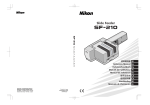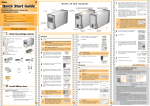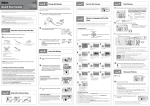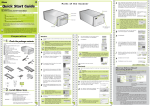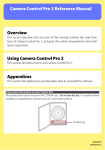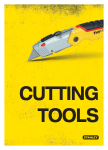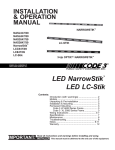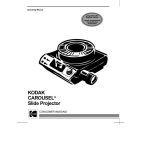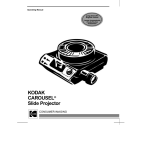Download Digital SF200 Specifications
Transcript
Slide Feeder SF-200 (S) Contents Cautions ..................................................................................................................................................................................................... 18 1. Overview .......................................................................................................................................................................................... 20 2. Parts and Accessories ................................................................................................................................................................ 21 3. Installation ......................................................................................................................................................................................... 22 4. Using the SF-200 (S) .................................................................................................................................................................. 24 5. Maintenance .................................................................................................................................................................................... 31 6. Specifications ................................................................................................................................................................................... 32 17 Cautions • The reproduction of this manual in whole or in part is prohibited save in cases in which Nikon’s prior permission has been obtained. • The information contained in this manual is subject to change without notice. • Nikon has made every effort to produce a perfect manual, but should you find any mistakes, we would be grateful if you would kindly let us know. The address of Nikon’s representative in your area is provided separately. • Nikon is not liable for damages resulting from the use of this product. Trademark Information All trade-names mentioned in this manual are the trademarks or registered trademarks of their respective holders. Symbol The symbols in this manual signify important safety precautions. All passages marked with this indication should be read prior to installation to prevent injury to yourself or to others. Symbol The symbols in this manual signify the need for caution when using the product. These indications are placed in sections that should be read before operation to prevent damage to the product. 18 Federal Communications Commission (FCC) Radio Frequency Interference Statement This equipment has been tested and found to comply with the limits for a Class B digital device, pursuant to Part 15 of the FCC Rules. These limits are designed to provide reasonable protection against harmful interference in a residential installation. This equipment generates, uses, and can radiate radio frequency energy and, if not installed and used in accordance with the instructions, may cause harmful interference to radio communications. However, there is no guarantee that interference will not occur in a particular installation. If this equipment does cause harmful interference to radio or television reception, which can be determined by turning the equipment off and on, the user is encouraged to try to correct the interference by one or more of the following measures: • • • • Reorient or relocate the receiving antenna. Increase the separation between the equipment and receiver. Connect the equipment into an outlet on a circuit different from that to which the receiver is connected. Consult the dealer or an experienced radio/television technician for help. CAUTIONS Modifications The FCC requires the user to be notified that any changes or modifications made to this device that are not expressly approved by Nikon Corporation may void the user’s authority to operate the equipment. Notice for customers in Canada CAUTION This class B digital apparatus meets all requirements of the Canadian Interference Causing Equipment Regulations. ATTENTION Cet appareil numérique de la classe B respecte toutes les exigences du Règlement sur le matériel brouilleur du Canada. Notice for customers in European countries ACHTUNG Dieses Gerät entspricht den Bestimmungen der EG-Direktive 87/308/EEC zur Störungsunterdrückung. Lärmemission kleiner 70 dBA Notice concerning prohibition of copying or reproduction Note that simply being in possession of material which has been copied or reproduced by means of a scanner may be punishable by law. • Items prohibited by law from being copied or reproduced Do not copy or reproduce paper money, coins, securities, government bonds, or local government bonds, even if such copies or reproductions are stamped “Sample”. The copying or reproduction of paper money, coins, or securities which are circulated in a foreign country is prohibited. Unless the prior permission of the government has been obtained, the copying or reproduction of unused postage stamps or post cards issued by the government is prohibited. The copying or reproduction of stamps issued by the government and certified documents stipulated by law is prohibited. • Cautions on certain copies and reproductions The government has issued cautions on copies or reproductions of securities issued by private companies (shares, bills, checks, gift certificates, etc.), commuter passes, or coupon tickets, except when a minimum of necessary copies are to be provided for business use by a company. Also, do not copy or reproduce passports issued by the government, licenses issued by public agencies and private groups, ID cards, and tickets, such as passes and meal coupons. • Comply with copyright notices The copying or reproduction of copyrighted creative works such as books, music, paintings, woodcut prints, maps, drawings, movies, and photographs is prohibited except when it is done for personal use at home or for similar restricted and non-commercial use. 19 1. Overview Thank you for your purchase of an SF-200 (S) slide feeder for 4000 ED (SUPER COOLSCAN 4000 ED) and LS-2000 (SUPER COOLSCAN 2000) Nikon film scanners. The SF-200 (S), which can hold up to fifty mounts 1.5 mm in thickness, automates the scanning of consecutive 35 mm slides. Like the other adapters for the 4000 ED and LS-2000, the SF-200 (S) can be inserted while the scanner is on and connected to a computer. This manual describes the procedures for unpacking, setting up, and connecting the feeder to your scanner. The next chapter, “Parts and Accessories,” details the contents of the package and the parts of the feeder. This is followed by “Installation,” which describes how to connect the feeder to the scanner. In “Using the SF-200 (S),” the procedures for loading and removing slides are explained. The final chapter, “Maintenance,” gives instructions on how to care for and transport the feeder. Please read all instructions thoroughly to ensure that you can get the most from your SF-200 (S). The procedures for scanning consecutive slides with the SF-200 (S) may be found in the software reference manuals provided on the CD-ROM that came with your scanner. We hope that you find this manual helpful. A Note on Nikon Scan If you are using the SF-200 (S) with LS-2000 film scanners, note that although Nikon Scan version 2.0 supports the SF-200 (S), it does not allow scanned images to be saved automatically. We recommend that you upgrade to version 2.1 or later. To determine the version currently installed on your computer: button in the Nikon Scan applet • Windows: click the • Macintosh: select About Nikon Scan from the Apple ( ) menu For information on upgrading to Nikon Scan 2.1 or later, visit the following URL: USA: http://www.nikontechusa.com Europe: http://www.nikon-euro.com 20 2. Parts and Accessories This chapter lists the items packaged with your slide feeder and identifies the parts of the SF-200 (S). 2.1 Package Contents Purchasers of the SF-200 (S) should find that the package contains all the items listed below. Should you find that anything is missing or damaged, contact your retailer immediately. SF-200 (S) slide feeder (1) Feed-mechanism attachment for rounded slide mounts (1) Reference manual (this manual) (1) 2.2 Parts of the SF-200 (S) Magazine cover Slide insertion guide Push plate Ejection magazine Feed magazine Status LED Load mark Push plate 21 3. Installation Before installing the SF-200 (S), make sure that your scanner is set up in a suitable location, as described in the documentation provided with the scanner. The SF-200 (S) should not be used where: • the temperature exceeds 35ºC (95ºF) or falls below 10ºC (50ºF) • it would be subject to condensation or drastic changes in temperature • the humidity exceeds 85% • it would be exposed to direct or reflected sunlight • it might be subject to vibration or strong physical shocks • there is a lot of dust • it would be exposed to radio interference from other electronic devices • it would be exposed to water vapor (e.g., from a humidifier) • it would be exposed to smoke Warning: Failure to observe the above precautions could result in fire or in scanner malfunction. The scanner must be on its base when the SF-200 (S) is used, and there must be sufficient space around the scanner to allow the magazine cover to open and to ensure adequate ventilation. There should be at least 15 cm (6″) of space above the unit and 10 cm (4″) open to the rear. Space requirements when the SF-200 (S) is attached are illustrated below. 22 The SF-200 (S) can be mounted on the scanner whether the scanner is off or on and connected to a computer. If the scanner is on, before mounting the feeder check that the status LED is glowing steadily. The SF-200 (S) should NOT be inserted or removed while the status LED is blinking. The scanner must be on its base before the SF-200 (S) can be inserted. If the scanner is currently installed on its side, turn the scanner onto its base. Slide the SF-200 (S) into the scanner’s adapter slot, stopping when the feeder contacts the back of the slot. The feeder should be oriented as shown below when inserted. Push the feeder until the connector on the rear of the feeder is seated securely in the socket at the back of the slot. The feeder is properly inserted if the status LED on the front of the feeder lights when the scanner is turned on. If the scanner is on when the feeder is inserted, the feeder’s status LED will blink to indicate that the feeder has been inserted correctly. In all other respects, the feeder LED functions in the same way as the scanner status LED. Power switch Status LED The illustration shows the SUPER COOLSCAN 4000 ED If the feed mechanism for the SF-200 (S) is not in the initial position when the scanner is turned on, you will need to wait a few seconds for the feed mechanism to return to initial position before inserting slides. Cautions • Wait until the status LED glows steadily or the scanner is off before inserting or removing the SF-200 (S). Do not attempt to remove or insert the feeder while the scanner is operating. • When the SF-200 (S) is inserted with the power on, or the scanner turned on after the feeder has been inserted with the power off, the feed mechanism will return to the initial position. While this operation is in progress, the status LED on the front of the feeder will blink. Do not perform any operations while the LED is blinking. • If the feeder does not slide in smoothly, remove it from the adapter slot and try again. Do not use force. 23 4. Using the SF-200 (S) This chapter describes how to load the SF-200 (S), how to remove slides, and how to deal with jams. 4.1 Loading the feeder Slides to be scanned are inserted in the feed magazine. To load the magazine, open the magazine cover, pull back the feed push-plate to the end of its grove, and hook it in the notch so that it does not spring back to its original position. Place the slides in the magazine with the long end of the aperture up and the emulsion surface facing the push plate (the images in the slides should be reversed when viewed from the magazine side). Scanning will be considerably simplified if the slides are all inserted in the same orientation. Magazine cover Push plate Ejection magazine Notch Load mark Slides can be loaded into the feed magazine up to the load mark. Do not attempt to fill the magazine past this point. Once the feed magazine is loaded, release the push plate from the notch and slide it back until rests against the slides. Close the magazine cover. You are now ready to begin scanning. For details on automatic consecutive scanning of multiple slides, refer to the software reference manual. 24 Cautions • Slides must be from 1.0 mm to 3.2 mm thick. • Mounts with rough surfaces could cause the feeder to jam. • Do not use mounts with peeling or burred edges, mounts to which seals or labels have been affixed, or mounts with sharp corners. Such mounts could jam the feeder or cause problems during scanning. • The feeder does not function equally well with all makes of slide mount. Makes that have projecting parts or are not of an even thickness may jam in the feeder. • Avoid slides with warped mounts. Warped slides may jam if placed in the feeder as shown below. Slide feeder viewed from above Warped slide mount • Do not load slides into the feeder with the longer side of the aperture facing the scanner, as this could damage the film or slide mount or cause the feeder to jam. Insert slides as shown by the insertion guide sticker next to the feed magazine. Insertion guide sticker To scanner ⇒ • Do not load slides in the feed magazine past the load mark, as this may cause the feeder to jam. • Do not move the scanner while scanning is in progress. • Remove scanned slides from the ejection magazine before the magazine is full. Continuing scanning when there is no room left in the ejection magazine could jam the feeder. • Do not remove the feeder while scanning is in progress. • Before turning the scanner off or removing the feeder, make sure that all slides have been removed from the magazine and that the last slide to be fed has been ejected. 25 Slide Mounts That Can Be Used in the SF-200 (S) • The following mounts have been tested and approved for use in the SF-200 (S): GEPE 3mm, GEPE 2mm, bonum, REVUE, AGFA system G, AGFA reflecta CS, Reflecta GR, Kaiser SR, hama fix, ROWI quickslide • The following mounts can be used only in restricted orientations: Mount Cautions Insert the slide with the front (the photograph side) facing the right of the SF-200 (S) (when the feeder is viewed from the front). When the slidemount adapter is used, slides can be inserted facing either direction. WESS Insert the slide with the front (the photograph side) facing the right of the SF-200 (S) (when the feeder is viewed from the front). hama DSR • The following mounts are known to cause jams: Kodachrome 1.1 mm cardboard mounts 26 Mount Notes PLASTIMOUNTS The uneven edges, surface projections, curled edges or apertures, or burrs on these mounts can cause jams. Pakon 4.2 Removing slides Slides will be sent to the ejection magazine after scanning. To remove slides from the ejection magazine, pull back the push plate and remove the slides. Slides must be removed before the ejection magazine fills up. 4.3 Using the Feed-Mechanism Attachment Thick mounts (over 2 mm thick) with rounded edges may not feed properly when used with the SF200 (S). A removable plastic part is provided for attachment to the feed mechanism, enabling the scanner to feed such slides. A special attachment utility program, provided with the Nikon Scan software that came with your scanner, is required both when attaching this part to and removing it from the feed mechanism. To attach the feed-mechanism attachment, the scanner must be connected to the computer and both scanner and computer must be on. After inserting the SF-200 (S) into the scanner as described above, open the FDUtility (Windows) or Utility (Macintosh) folder in the folder to which you installed Nikon Scan and then double-click the Attachment Utility icon to start the attachment utility. Windows Macintosh The attachment utility window will appear on the desktop. If more than one scanner is attached to your computer and powered on, select the scanner to which the SF-200 (S) is attached from the select a scanner pop-up menu. Nikon Scan does not support simultaneous connection of more than one 4000 ED. If more than one scanner of the same type is connected, only one of the devices will appear in the Tools menu. 27 Open the SF-200 (S)’s magazine cover, pull back the feed push-plate to the end of its grove, and hook it in the notch so that it does not spring back to its original position. Click the double right-arrow button in the attachment utility to move the feed mechanism to where it is fully visible. If you move the feed mechanism too far, click the left-arrow button to move it back. The single-arrow buttons can be used for fine adjustments. Once the feed mechanism is visible, insert the pegs on the attachment into the holes in the feed mechanism. Feed-mechanism attachment Click the OK button in the attachment utility window to return the feed mechanism to its initial position. You are now ready to begin scanning. 4.4 Removing attachment When scanning slides with flat mounts or slides less than 2 mm thick, you will need to remove the attachment. Use the attachment utility as described above to move the feed mechanism into the magazine, then remove the attachment and click OK to return the feed mechanism to its initial position. Caution Be sure that the attachment is securely in place. If the attachment is loose, slides may not feed properly and damage to the SF-200 (S) could result. 28 4.5 What to do if the feeder jams If a jam occurs, open the magazine cover and remove the slides remaining in the feed and eject magazines. Pull back the feed push-plate and hook it in the notch so that it does not spring back to its original position. The method for resolving a jam depends on the position of the feed mechanism when the jam occurred. If the jammed slide is visible in the magazine and the feed mechanism has returned to its housing in the front of the unit, the jammed slide can be removed with your fingers. If the feed mechanism has locked while feeding a slide, you will need to use the attachment utility to resolve the jam (the attachment utility is a special program for the SF-200 (S) distributed with the Nikon Scan software that came with your scanner). To use the attachment utility, open the FDUtility (Windows) or Utility (Macintosh) folder in the folder to which you installed Nikon Scan and double-click the Attachment Utility icon to start the attachment utility. Windows Macintosh 29 The attachment utility window will appear on the desktop. If more than one scanner is attached to your computer and powered on, select the scanner to which the SF-200 (S) is attached from the select a scanner pop-up menu. Nikon Scan does not support simultaneous connection of more than one 4000 ED. If more than one scanner of the same type is connected, only one of the devices will appear in the Tools menu. If the feed mechanism has locked while pushing a slide, click the double left-arrow button in the attachment utility window to move the feed mechanism back to its housing, then remove the jammed slide with your fingers. If two or more slides have jammed so that they overlap, remove the slide on the magazine side first. If the mount has caught at the entrance to the ejection magazine while being ejected from the feeder, click the right arrow button to move the feed mechanism out of the way, then push the slide back gently back towards the scanner to clear the jam. Using the left-arrow button, return the feed mechanism to its housing (if this does not clear the jam, you will need to take the feeder to a Nikon service center for repairs). 30 5. Maintenance This chapter describes how to clean, store, and transport the SF-200 (S). 5.1 Cleaning Before cleaning the feeder, remove it from the scanner. The exterior of the feeder is made of plastic, and should not be cleaned with volatile cleaners such as alcohol or paint thinner. Use a blower to blow off dust or wipe the surface with a dry cloth. If this is not sufficient to remove all dirt, clean with a cloth that has been slightly dampened with a neutral detergent or liquid soap. Warning: Do not use water or a volatile liquid such as alcohol, benzine, or thinner. Should any of these liquids enter the feeder, fire or electric shock could result. Volatile chemicals could also stain the plastic exterior of the feeder. 5.2 Storage When you do not plan to use the feeder for an extended period of time, remove it from the scanner. Store in a dry, well-ventilated environment, away from electronic equipment such as televisions or radios which produce strong magnetic fields. Do not store the feeder where the temperature exceeds 60ºC (140ºF) or goes below –20ºC (–4ºF), or where the humidity is less than 20% or more than 90%. 5.3 Transport When transporting the scanner, remove the feeder from the scanner and pack it in the original packing material. 31 6. Specifications Film: 35 mm slide mount of 1.0 to 3.2 mm in thickness Maximum number of slides: Approx. 50 slides with mounts 1.5 mm in thickness (Housing space: Approx. 78.5 mm) Operating mode: 4000 ED/LS-2000 installed on its base, SF-200 (S) connected directly to the connector at rear of scanner adapter slot Feed/eject time (reference): Feed: approx. 6 seconds per slide Eject: approx. 6 seconds per slide Dimensions: 32 142 mm (W) × 325 mm (D) × 85 mm (H) (5.63″ × 12.78″ × 3.37″) Weight: Approx. 700 g (1 lb 9.0 oz) Power supply: 5 VDC, 0.7 A or less, supplied from scanner Operating environment: Operating temperature1 +10ºC to +35ºC Humidity 20% to 85% (no condensation)
















